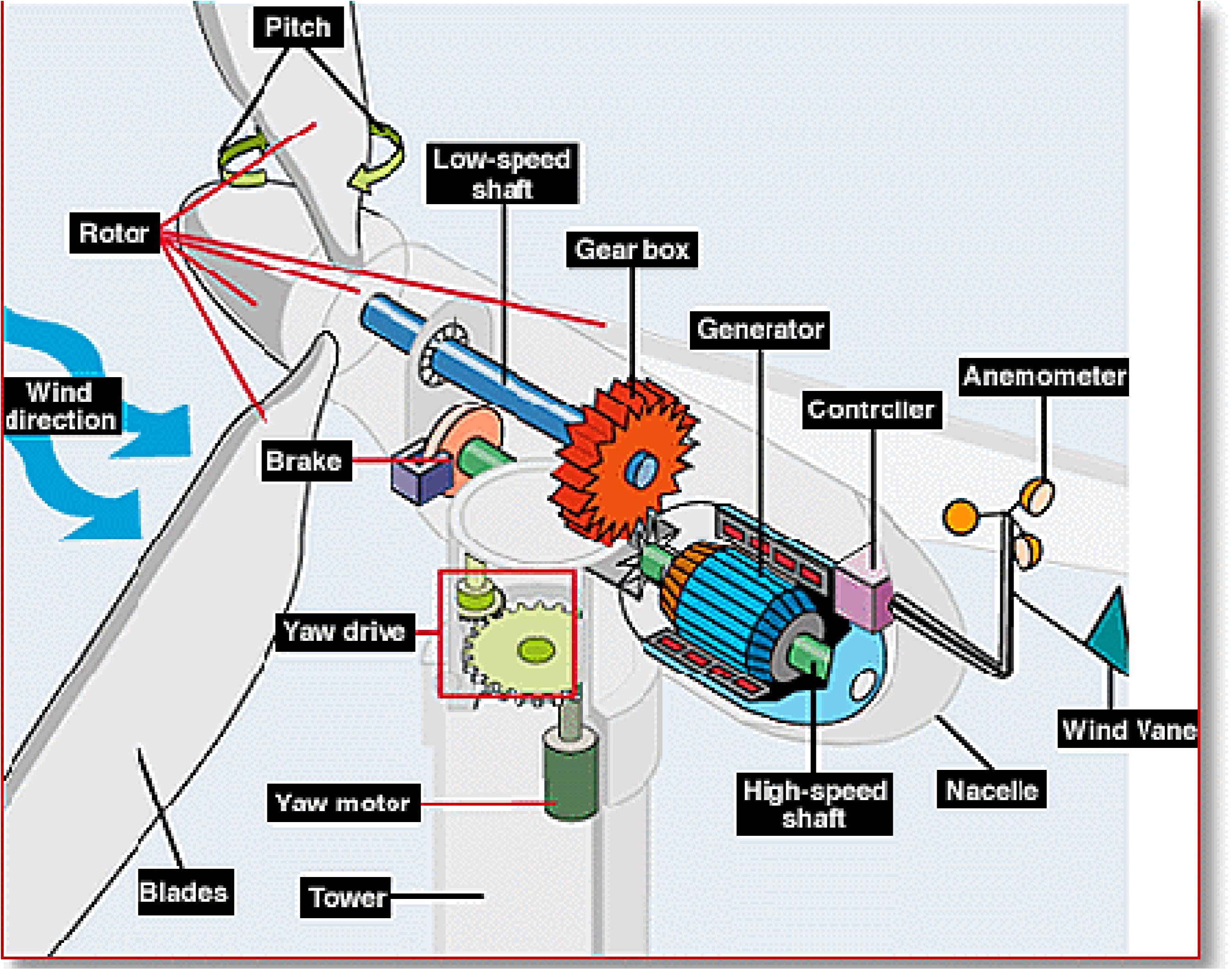Chapter:
What does wind turbine contains or components of wind turbine?

Rotor:
Blades:
Blade is a
rotating component designed aerodynamically to work on the principle of lift
and drag to convert kinetic energy of wind into mechanical energy which is
transferred through shaft then converted to electrical energy using generator.
Most turbines have either two or three blades. Wind blowing over the blades
causes the blades to "lift" and rotate. Mechanical applications like
pumping water, grinding uses more number of blades as it requires more torque.
Blade length is key factor determining power generation capacity of a wind
turbine.
Nacelle:
The nacelle is an enclosure
that sits atop the tower and contains the gear box, low-speed shaft and
high-speed shaft, generator, controller, and brake. Some nacelles are large
enough for a helicopter to land on. The nacelle also protects turbine
components from atmospheric weather conditions and reduces noise.
Low-speed shaft:
Low-speed shaft is the
principle-rotating element which transfers torque from the rotor to the rest of
drive train. It also supports the weight of the rotor. It is connected to the
gearbox to increase the rpm.
Gear box:
Gear box steps
up the speed according to the requirement of the electric generator. Gears
connect the low-speed shaft to the high-speed shaft and increase the rotational
speeds from about 30 to 60 rotations per minute (rpm) to about 1000 to 1800
rpm, the rotational speed required by most generators to produce electricity.
The gear box is one of the costliest (and heavy) parts of the wind turbine and
there are also "direct-drive" generators that operate at lower
rotational speeds and don't need gear boxes.
Types: Planetary Gear Boxes, Parallel shaft gear.
High-speed shaft:
Transmits the speed & torque from the gearbox and drives the
generator.
Brake:
During the periods of
extremely high winds and maintenance, brakes are used to stop the wind turbine
for its safety.
Types of
Brakes: mechanical brake (Disc brake, clutch brake), Aerodynamic brake (Tip brake
and spoilers)
Generator:
Generator converts the
rotational mechanical energy into electrical energy. Usually wind electric
generator produces 50-cycle AC electricity.
Types:
Synchronous generator (Electrically excited, permanent magnet), asynchronous
generator (Squirrel cage, Slip ring)
Controller:
The controller starts up
the machine at cut-in wind speed (generally 3 m/s) and shuts off the machine at
cut-out wind speed (generally 25 m/s) as per the design requirement. The
controllers also operate the turbine to produce grid-quality electricity. The
controller measures and controls parameters like Voltage, current, frequency,
Temperature inside nacelle, Wind direction, Wind speed, The direction of
yawing, shaft speed, Over-heating of the generator, Hydraulic pressure level,
Correct valve function, Vibration level, Twisting of the power cable, Emergency
brake circuit, Overheating of small electric motors for the yawing, hydraulic
pumps, Brake-caliper adjustment etc.
Anemometer:
Anemometer is a
sensor used for measuring the wind speed. Other than using it for wind resource
assessment, it is normally fixed on top of the wind turbine to provide input to
the controller for power regulation and braking beyond the cut out &
survival wind speed .

Pitch:
Blades are turned or
pitched, out of the wind to control the rotor speed and keep the rotor from
turning in winds that are too high or too low to produce electricity.
Tower:
The tower
enables wind energy utilization at sufficient heights above ground, to absorb
and securely discharge static and dynamic stress exerted on the rotor, the
power train and the nacelle into the ground.
Types: Lattice tower, tubular tower, Guyed tower, Hybrid Tower
Foundation (not shown in
the picture)
Foundation is needed to support
and absorb the loads from the wind turbine. The choice of foundation type is
much dependent on the soil conditions and water table location prevailing at
the planned site of a wind turbine.
Onshore Foundation Types: Slab Foundation (preferred when the top soil is
strong), Pile Foundation (Preferred
when the top soil is of a softer quality)
Offshore Foundation Types: Monopile, Gravity base, Tripod
Wind vane:
Measures wind direction and
communicate with the controller for orienting the turbine properly (yawing)
with respect to the wind direction.
Yaw drive:
Yaw drive turns the nacelle
with rotor according to the wind direction using a rotary actuator engaging on
a gear ring beneath the nacelle. Yaw system keeps the turbine always facing the
wind.
Yaw motor:
Yaw motor is to power the yaw drive.
Related Topics